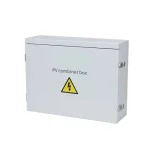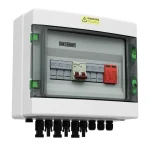As solar energy systems continue to evolve, the components used in photovoltaic (PV) installations have also become more specialized. Two essential but often confused devices in DC side wiring are the PV combiner box and the traditional DC junction box. While both serve the purpose of connecting and managing solar panel wiring, their design, safety features, and functionality differ significantly.
In this article, we’ll break down the key differences between these two types of boxes and help you determine which is better suited for your solar project.
What Is a Traditional DC Junction Box?
A DC junction box is a basic enclosure used to connect multiple DC cables in a solar system. It typically includes terminals or bus bars where positive and negative wires from solar panels or other DC sources are joined. Traditional junction boxes are often used in small-scale systems or older installations where minimal protection and monitoring were acceptable.
Key Features:
Basic wire management and consolidation
Typically lacks surge protection or fuses
May not include monitoring features
Lower cost, but limited safety and scalability
What Is a PV Combiner Box?
A PV combiner box is a more advanced device that consolidates multiple string inputs from solar panels and feeds them into a single DC output for the inverter. It includes essential safety features like fuses, surge protection devices (SPDs), disconnect switches, and even monitoring options for current and voltage.
Key Features:
Designed specifically for solar PV systems
Multiple inputs (strings) with fuse protection
Integrated DC SPD and isolator switch
Supports system safety, maintenance, and performance monitoring
Required in medium to large-scale solar installations

Metal Enclosures PV Combiner Box

Plastic Enclosures PV Combiner Box
Side-by-Side Comparison
When Should You Use a PV Combiner Box?
You should use a PV combiner box when:
You have more than two or three PV strings.
Your system is over 3 kW and requires safety standard compliance.
You want to include SPD and monitoring for better system health.
You need structured, scalable, and maintainable DC wiring.
In contrast, a traditional DC junction box may still be suitable for:
DIY or off-grid setups under 1–2 kW
Systems with no need for future expansion
Budget-sensitive installations with lower safety priorities
Why PV Combiner Boxes Are the Future of Solar Wiring
As national and international electrical codes grow more rigorous, combiner boxes have become essential for any professional PV installation. They not only protect your equipment but also make maintenance safer and faster. Combiner boxes support string-level monitoring, which is critical in troubleshooting faults and optimizing system efficiency.
At Derlicn Electric, our DLCB Series PV Combiner Boxes are engineered for reliability, safety, and performance. We offer:
Wide input configurations (2-in-1-out to 24-in-1-out)
Compatible voltage levels (600V / 1000V / 1500V)
Integrated high-speed DC SPD and isolators
IP65+ enclosures for outdoor durability
Need Help Choosing the Right Solution?
Still not sure which box is right for your system? Let our engineers help you design a solar solution tailored to your site, panel configuration, and safety requirements. Whether you’re planning a rooftop array, a commercial installation, or a solar farm — we’ve got you covered.
👉 Contact us today for product catalogs, custom quotations, and technical consultation.
Table of Contents
Have you Any Questions?
Can’t find an answer to your question, or want more information about our products? If so, please feel free to get in touch with our professional team. We’re here to help you drive your projects to success.

